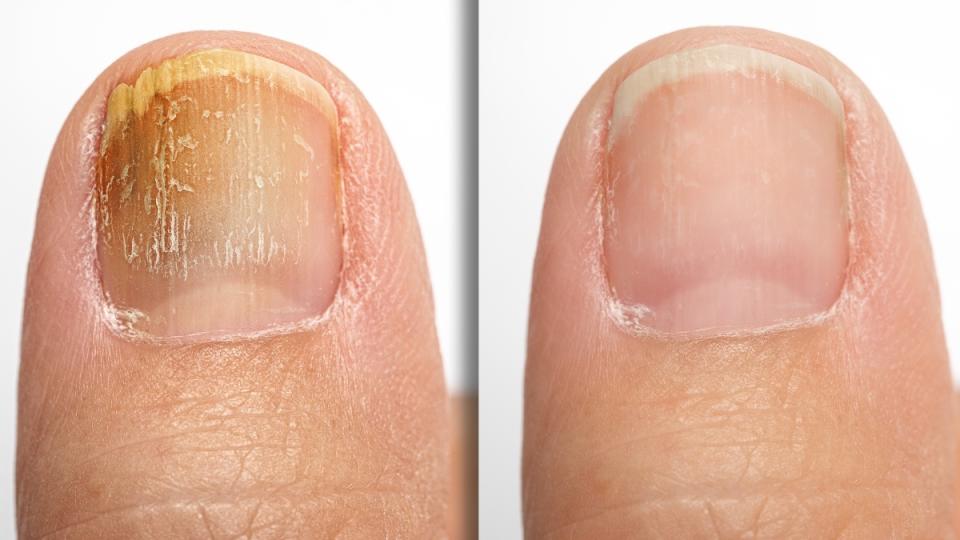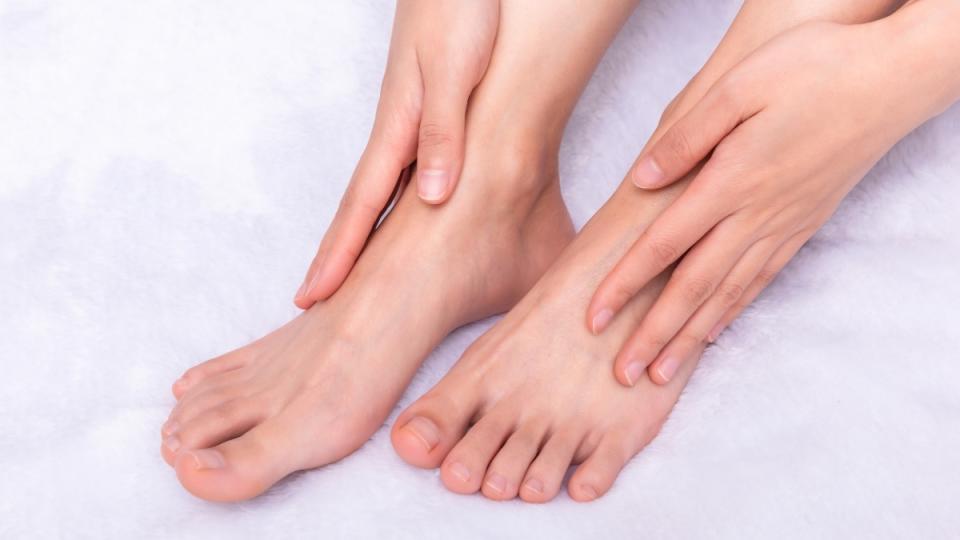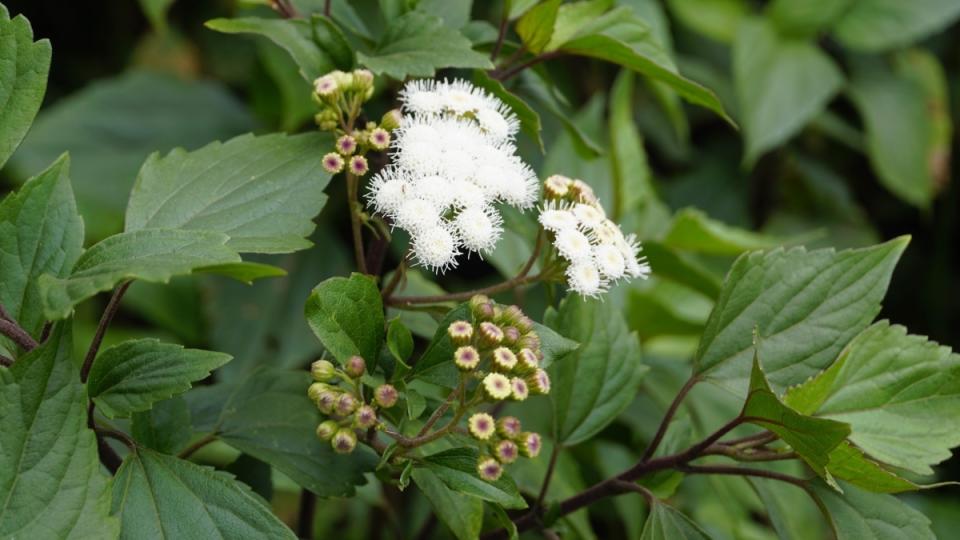Here’s How To Tell if Your Toenail Fungus Is Dying + 3 Natural Remedies To Speed Healing
If your favorite sandals are sitting in the closet because of unsightly thick and yellow nails, you might be wondering how to know if toenail fungus is dying already. It turns out getting rid of this stubborn condition can require lots of patience.
Even if you’re doing everything under the sun to get your toenails fungus-free, “visible improvement can take as long as a year to observe as the nail grows out,” says Chelsey Straight, MD, a double board-certified dermatologist and founder of Pure Dermatology in Austin, Texas. We asked Dr. Straight and other MDs to explain once and for all what toenail fungus is, how to know if it’s actually dying and how to block it from coming back.
What is toenail fungus?
Toenail fungus, also known as onychomycosis, is an infection that gets in through cracks in your nails or cuts in your skin. It can make your toenails change color, get thicker or become brittle, explain Dr. Straight.
“At its core, toenail fungus is a fungal infection that penetrates and thrives within the nail bed itself,” adds Naheed Ali, MD, author of Living with Metabolic Syndrome. “It announces itself with that dreaded yellow or white discoloration spreading across the nail. From there, the nail develops crumbly edges and grooved ridges as the fungus digs in deeper.”

Related: How to Remove an Ingrown Toenail Yourself + The Dental Floss Hack That’s All Over TikTok
Top causes of toenail fungus
Dermatophytes, a group of fungi that can degrade the skin, hair and nails, are the most common cause of toenail fungus. “The usual culprit is a specific fungus called trichophyton rubrum,” says Dr. Straight. Fungus isn’t the only source of problems, though. Yeasts can also cause toenail fungus.
Dr. Straight says certain situations make a toenail infection more likely, too. “Older age, a weakened immune system, frequent dampness of the feet and diabetes all make someone more susceptible,” she reveals. As can an injury along the nails, which increases the number of chances fungus or yeast can get in.
What else can contribute to toenail fungus? Not keeping your feet sufficiently clean and dry. “Toenail fungus absolutely loves warm, moist environments like sweaty shoes and socks,” Dr. Ali says.
If you suspect you have toenail fungus, visit your doctor. The earlier you catch it, the sooner you can treat and kill it. “The duration of the toenail fungus will depend on the treatment method and the extent of the infection,” says Dr. Straight. You’ll need to stick with your treatment plan for about three months to a year.
“The tough truth is that toenail fungus is incredibly stubborn,”adds Dr. Ali. “Even with strong treatment, full clearing can take nine to 12 long months as you await the entire infected nail growing out and being replaced. Staying patient, keeping feet clean and dry and vigilantly preventing re-infection during that process is absolutely crucial.” In the most severe cases, removing the entire nail may be required for full resolution, he notes.
How to know if toenail fungus is dying
Because killing toenail fungus is a slow and gradual process, it can be hard to know if the fungus is dying, says Dr. Straight. “Even after the fungus is dead, the nail may continue to show signs of the infection until a new nail grows." She suggests looking for a reduction in nail thickness and discoloration as signs you're moving in the right direction. “These changes may take several months to observe due to the slow growth rate of nails,” she says.

For the very first signs that toenail fungus is dying, look to the nail base. “You'll notice healthy, new nail growth finally starting to appear at the base, pushing that thick, discolored and damaged portion out," says Dr. Ali. “That's the big victory signaling you're on the mend.”
What if your toenail fungus is not dying?
Now that you know how to tell if your toenail fungus is dying, what happens if yours doesn't seem to be responding to treatment? People often need medications to clear up severe or stubborn fungal nail infections. “Prescription oral antifungals are my treatment of choice," says Dr. Straight. "Specifically, terbinafine and itraconazole are highly effective." This type of Rx is often preferred by doctors and patients because it can get rid of toenail fungus in only two to three months.
Topical treatments, including ciclopirox and efinaconazole (which goes by the brand name Jublia), can also work, says Dr. Straight. Just be prepared to wait longer for the toenail fungus to die. “These agents may require up to a year to work,” she notes.
Several over-the-counter (OTC) treatments for toenail fungus are available, too. These include antifungal creams, ointments and nail polishes. “Over-the-counter topical treatments like amorolfine or ciclopirox can sometimes do the trick if you catch it extremely early on,” says Dr. Ali.
That said, Dr. Straight isn’t a fan of the OTC route. “The reality is that over-the-counter treatments often do not work,” she says. Your doctor can help you decide if an OTC remedy is worthy trying.
Related: Skip a Trip to the Doctor’s Office — You Can Heal an Infected Hangnail at Home in 4 Easy Steps
3 natural remedies for toenail fungus
If you prefer to try a natural treatment for your toenail fungus, there are a few options. Here’s what the research suggests may help:
1. Tea tree oil
Tea tree oil is known for its antifungal and antiseptic properties. A small study of 20 people in Skin Appendage Disorders found a blend of oils, including tea tree oil, cured toenail fungus in about 80% of participants. Simple apply it to the toenails as well as the soft tissue around the nails once a day for six months. The blend in the study also included vitamin E and essential oils of lime and oregano. While there’s no ready-made commercial equivalent, you can talk to your doctor about trying this blend of oils at home. (See how tea tree oil can clear up eczema, too.)

2. Vinegar
Vinegar can create an acidic environment that inhibits fungal growth, according to Harvard Medical School experts. Simply mix one part white or apple cider vinegar to three parts warm water in a bowl or basin. Then soak your toes for 40 minutes once or twice a day until you know the toenail fungus is dying. (Discover more natural ways to get rid of toenail fungus.)
3. Snakeroot extract
Despite its exotic name, snakeroot extract is a natural antifungal derived from plants in the sunflower family. And research in American Family Physician showed that it cleared up toenail fungus for 59% of patients in six months after once-daily application. Foot Dope toenail treatment combines snakeroot extract with tea tree oil, oregano and other essential oils to speed results.

Albin Raj/Getty
Note: While natural remedies can occasionally provide relief, especially when toenail fungus is caught early, more research is still needed. “I don’t typically recommend natural remedies in my practice because their clinical efficacy isn't well-supported by medical literature,” says Dr. Straight. “My patients are always welcome to try these options because they’re harmless, but I don’t believe they’re effective.”
How to prevent toenail fungus from returning
Because toenail fungus can be so tough to treat, it’s worth making an effort to keep it from coming back once you've cleared the infection. Here’s what Dr. Straight advises:
Wash your feet daily with soap and water and dry them thoroughly, especially between the toes.
Keep your toenails trimmed and avoid picking at or damaging the skin around your nails.
Wear breathable shoes and socks made of natural fibers like leather, canvas, cotton or wool. Rotate your shoes to allow them to fully dry out between wears. Avoid tight, synthetic shoes and socks that can trap moisture.
Wear shower shoes or flip-flops in public areas like pools, locker rooms and showers. Don’t go barefoot in public places.
Inspect your feet and toes regularly for any changes in color, texture or appearance to catch a potential toenail infection in the earliest stage.
If you’ve had past toenail fungus infections, apply Lamisil cream to the bottoms of your feet once a week and spray your shoes with Tinactin spray to keep it from coming back.
For more ways to solve common nail bothers:
How to Remove an Ingrown Toenail Yourself + The Dental Floss Hack That’s All Over TikTok
Skip a Trip to the Doctor’s Office — You Can Heal an Infected Hangnail at Home in 4 Easy Steps
This content is not a substitute for professional medical advice or diagnosis. Always consult your physician before pursuing any treatment plan.


